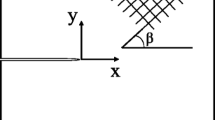Abstract
In this paper, we report on an experimental study of spontaneous, mixed-mode, crack propagation in weakly bonded similar and dissimilar materials. A unique experimental configuration is proposed to induce spontaneous crack growth events along the interfaces. The cracks nucleate from tiny circular holes and are triggered by an exploding wire. They subsequently propagate under the action of a constant, far-field load. Dynamic photoelasticity in conjunction with high speed photography is used to capture the real-time isochromatics associated with crack propagation. In the case of identical materials, crack propagation is anti-symmetric with respect to the crack nucleation point while strong asymmetry is observed for the case of dissimilar materials. In both cases, cracks propagate at constant velocity from the initiation point. The time histories of dynamic stress intensity factors and of energy release rates of the propagating cracks along the bonded similar materials are also reported.
Similar content being viewed by others
References
Ravichandar K, Knauss WG (1984) An experimental investigation into dynamic fracture. 1. Crack initiation and arrest. Int J Fract 25(4):247–262.
Ravichandar K, Knauss WG (1984) An experimental investigation into dynamic fracture.4. On the interaction of stress waves with propagating cracks. Int J Fract 26(3):189–200.
Ravichandar K, Knauss WG (1984) An experimental investigation into dynamic fracture. 3. On steady-state crack-propagation and crack branching. Int J Fract 26(2):141–154.
Ravichandar K, Knauss WG (1984) An experimental investigation into dynamic fracture. 2. Microstructural aspects. Int J Fract 26(1):65–80.
Ravichandran G, Clifton RJ (1989) Dynamic fracture under plane-wave loading. Int J Fract 40(3):157–201.
Washabaugh PD, Knauss WG (1994) A reconciliation of dynamic crack velocity and Rayleigh-wave speed in isotropic brittle solids. Int J Fract 65(2):97–114.
Lambros J, Rosakis AJ (1995) Development of a dynamic decohesion criterion for subsonic fracture of the interface between two dissimilar materials. Proc R Soc Lond A451:711–736.
Lambros J, Rosakis AJ (1995) Dynamic decohesion of bimaterials—Experimental-observations and failure criteria. Int J Solids Struct 32(17–18):2677–2702.
Rosakis AJ, Samudrala O, Singh RP, Shukla A (1998) Intersonic crack propagation in bimaterial systems. J Mech Phys Solids 46(10):1789–1813.
Singh RP, Lambros J, Shukla A, Rosakis AJ, (1997) Investigation of the mechanics of intersonic crack propagation along a bimaterial interface using coherent gradient sensing and photoelasticity. Proc R Soc Lond A453:2649–2667.
Coker D, Rosakis AJ, Needleman A (2003) Dynamic crack growth along a polymer-Homalite interface. J Mech Phys Solids 51(3):425–460.
Rosakis AJ, Samudrala O, Coker D (1999) Cracks faster than the shear wave speed. Science 284(5418):1337–1340.
Rosakis AJ (2002) Intersonic shear cracks and fault ruptures. Adv Phys 51(4):1189–1257.
Kavaturu M, Shukla A (1998) Opening-mode dominated crack growth along inclined interfaces: Experimental observations. Int J Solids Struct 35(30):3961–3975.
Kavaturu M, Shukla A (1999) Dynamic fracture of curved interfaces. Int J Fract 100(3):L3–L8.
Dally JW, Riley WF (1991) Experimental Stress Analysis. McGraw-Hill, New York.
Xia KW, Rosakis AJ, Kanamori H (2004) Laboratory earthquakes: The sub-Rayleigh-to-supershear rupture transition. Science 303(5665):1859–1861.
Liu C, Rosakis AJ (1994) On the higher-order asymptotic analysis of a nonuniformly propagating dynamic crack along an arbitrary path. J Elast 35(1–3):27–60.
Samudrala O, Rosakis AJ (2003) Effect of loading and geometry on the subsonic/intersonic transition of a bimaterial interface crack. Eng Fract Mech 70(2):309–337.
Qian W, Sun CT (1998) A frictional interfacial crack under combined shear and compression. Compos Sci Technol 58:1753–1761.
Xia KW, Rosakis AJ, Kanamori H, Rice JR (2005) Inhomogeneous faults hosting earthquakes in the laboratory: directionality and supershear. Science 308:681–684.
Author information
Authors and Affiliations
Corresponding author
Rights and permissions
About this article
Cite this article
Xia, K., Chalivendra, V.B. & Rosakis, A.J. Spontaneous Mixed-Mode Fracture in Bonded Similar and Dissimilar Materials. Exp Mech 46, 163–171 (2006). https://doi.org/10.1007/s11340-006-6423-7
Received:
Accepted:
Published:
Issue Date:
DOI: https://doi.org/10.1007/s11340-006-6423-7




